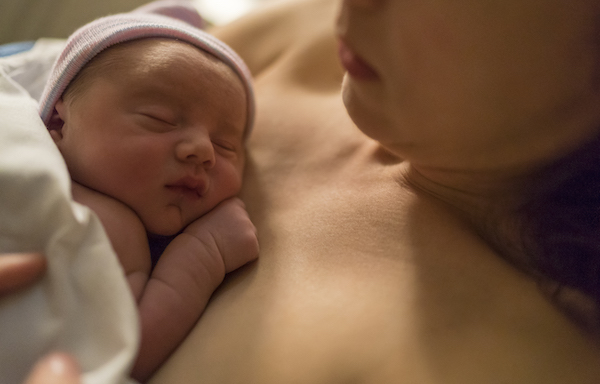Not too hot, not too cold: Keeping newborns at just the right temperature
April 4, 2023

Before a baby is born, their mother’s body keeps them at a comfortable, healthy temperature. In the first few hours after birth, though, it can take a while for a newborn to regulate his or her own body temperature.
Keeping a newborn within a normal temperature range right after delivery is important to their immediate and long-term health. Research has shown that babies born full-term with first temperature readings lower than 96.8°F are at increased risk for respiratory problems and low blood sugar. Premature infants with low temperatures are more susceptible to infections, respiratory problems, and blood sugar complications that can last several months and even be fatal.
UT Southwestern has joined more than 160 Texas hospitals in the Newborn Admission Temperature (NAT) project, run by the Texas Collaborative for Healthy Mothers and Babies. The TCHMB has published guidelines for temperature regulation in preterm infants and infants who are born full-term.
We are submitting quarterly data, such as newborn temperatures at 20 to 60 minutes after birth in the mother-baby unit and upon admission to the neonatal intensive care unit (NICU) to help pinpoint areas in which hospitals can be more proactive, enhance guidelines, and give parents the latest recommendations to keep their newborns warm and healthy after delivery.
What can make a baby cold after birth?
A newborn’s temperature should be between 96.8°F and 99.5°F (36°C and 37.5°C). If they are below that range, the baby’s temperature is considered too cold (hypothermic); above that number is too hot (hyperthermic).
Many factors at the time of birth can predispose babies to getting cold. Babies are wet from the amniotic fluid at delivery, and evaporation can lower their temperature. Delivery rooms tend to be kept a little cooler than room temperature because the mother is working hard, there are a lot of warm lights, and doctors and nurses wear thick garments and safety apparel, such as caps and masks.
The smaller and more premature a baby is, the higher the risk of them becoming cold, so we follow different strategies depending on a baby’s gestational age and birth weight.
Full-term infants
Kangaroo care, or skin-to-skin contact with the mother, is the best first step for temperature regulation in a full term, healthy weight newborn. As soon as possible after delivery, we will place the baby on the mother’s chest, covering them with a blanket. Our goal is for the two to snuggle like this for 60 to 90 minutes.
Though partners and family members will be eager to hold the new baby, this time is important for the baby’s health. Let loved ones know ahead of time they may need to wait to cuddle the new baby. Kangaroo care has been shown to improve babies’:
- Sleep
- Weight gain
- Breastfeeding success
- Breathing regulation
- Heart rate
We also try to keep new mothers’ rooms at about 73°F (22.7°C) after delivery to help babies stay at the correct temperature. If baby still becomes a little cold, we may place them under a radiant warmer for 15 to 30 minutes and have them wear a hat.
Preterm infants
Babies born before their due date or at a low birthweight may not be stable enough for skin-to-skin contact with mom right after birth. Infants who are born at 32 weeks’ gestation or sooner or weigh less than 3.3 pounds are brought to the radiant warmer and wrapped in neowrap, which is a neck-to-toes polyethylene wrap designed to reduce evaporative heat loss. The garment may look like a plastic blanket or a large Ziplock bag, but it is designed to keep body heat in and cold external air out. If they are born at 28 weeks or earlier, we will also use a thermal mattress.
Once the baby arrives in the NICU, we place them in an isolette that provides a steady temperature and humidity level as high as 60%-70%, which helps with temperature regulation and reduces evaporative loss.
Temperature regulation tips at home
Many of our guidelines focus on keeping baby from getting too cold while they’re in our care. At home, overheating can also be a concern. Swaddling, turning up the heat unnecessarily, and dressing the baby in extra layers can cause overheating.
Signs that your baby is too warm include sweating, flushed cheeks, a heat rash, or rapid breathing. Here are a few tips to prevent overheating at home:
- Set your thermostat between 72°F (22.2°C) and 75°F (23.8°C).
- Dress the baby in the same number of layers you’re wearing. For example, they shouldn’t need a hat or jacket in the house.
- Dry the baby well after bathing.
- Resist the urge to bundle the baby for car rides – they’ll get too warm, and extra layers of clothes create too much space between the car seat straps and the baby’s body.
While adults often get a fever when they’re sick, that is not always the case with newborns. In fact, a newborn may have a low body temperature when they have an infection. Call your pediatrician if your baby’s temperature is too high or too low.
It takes time for a newborn to get used to life outside the womb, and that includes developing the ability to regulate their temperature. Participating in the Newborn Admission Temperature project is a chance for UT Southwestern and hospitals statewide to give more families and clinicians clear guidelines that will help more newborns stay at a comfortable, healthy temperature.
To talk with a pediatrician or newborn care expert, call 214-645-8300 or request an appointment online.











